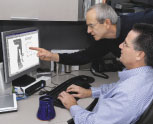Working Model 2D
2D Dynamic Motion Simulation

NASA JPL Uses Working Model 2D and 3D for Asteroid Mission with Japanese Space Institute

NASA Jet Propulsion Laboratory (JPL) is using motion simulation software from Working Model, Inc., to develop, test, and integrate a robotic rover as part of the first asteroid mission ever with Japan’s Institute of Space and Astronautical Science (ISAS).
The asteroid’s low gravity field poses specific challenges for this mission. JPL is using motion simulation software to experiment with the rover’s movements during the initial design phase of this sophisticated robotic mechanism.
Mission Possible
Known as MUSES-C, the mission will be launched on a Japanese M-5 spacecraft in January 2002 from Kagoshima Space Center, Japan. It is scheduled for a touchdown on the asteroid Nereus in September 2003, and a return to Earth in 2006. The goal of the mission is to collect samples from the asteroid’s surface and bring them back to Earth for in-depth study.
Nereus, a small, near-Earth asteroid roughly one mile in diameter, was discovered in 1982. At its closest point to the Sun, its orbit takes it just inside the Earth’s orbit. Scientists want to study Nereus because its composition, rotations, and length of days and nights remain a mystery.
"With a successful mission, we will have the first direct insight into the composition of the materials that helped form the rocky inner planets more than four billion years ago," says Dr. Jurgen Rahe, director of Solar System Exploration at NASA headquarters in Washington, DC. NASA and ISAS will cooperate on several aspects of the mission, including mission support and scientific analysis.
The Rover
NASA JPL will design and build the rover for an independent study of the asteroid surface. JPL, a division of the California Institute of Technology and a NASA field center, is the lead U.S. center for robotic exploration of the solar system.
JPL creates spacecraft, including robotic arms and rovers, that have visited all known planets except Pluto. In addition to its work for NASA, JPL conducts tasks for a variety of other federal agencies.
The rover will be the smallest ever flown in space. Its physical dimensions are 6 inches by 6 inches by 4 inches, with a mass of less than 500 grams (2.2 pounds). The four-wheeled rover will carry two scientific instruments: a visible spectrum imaging camera and a near-infrared point spectrometer. The camera will record the asteroid’s physical form through photographs while the spectrometer will study its surface properties.
The rover will "ride" as an attachment to the ISAS spacecraft during flight and then will "hop off" just prior to the asteroid sampling event on Nereus. Solar energy will power the rover’s movements while the ISAS spacecraft will assist with communications for beaming rover data to Earth.
The mission will complete another NASA JPL engineering exercise. "We hope the mission will send back valuable data from Nereus that will be science useful for both engineers and scientists on Earth," comments Dr. Eric T. Baumgartner, Ph.D., of JPL’s Science and Technology Development Section in the Mechanical Engineering Division. He is involved in efforts related to the design and development of the rover.
Considerable Challenges
Space missions present considerable challenges because of the many unfamiliar or unknown factors involved. In this case, the asteroid’s extremely low gravity field will greatly affect the rover’s mission. "While Mars has one third of the Earth’s gravity, and the moon one eighth, Nereus has 0.00002, which makes rover movements highly unpredictable," Dr. Baumgartner remarks.
This significant factor has particular ramifications for the rover, whose sole purpose is to explore the asteroid’s surface. Without a reasonable amount of gravity, the rover’s wheels would not have sufficient traction, and could possibly fly right off the asteroid.
Rover Dynamics with Working Model
Dr. Baumgartner has been using Working Model® 2D and Working Model® 3D, software from Working Model, Inc., to visualize the mechanical performance of the rover on the asteroid’s surface. Working Model is a motion simulation software program that enables mechanical engineers to perform design studies without building physical prototypes.
Dr. Baumgartner first used Working Model 2D version 4.0 to analyze the rover’s dynamics. As a result, he clearly saw that the asteroid’s miniscule level of gravity sufficiently provided traction for the wheels of the rover. "Working Model 2D simply helped us to get the rover’s wheels turning," he notes.
According to Dr. Baumgartner, using Working Model 2D helped determine what the rover can do. This naturally led to investigating ways to command the vehicle.
For this next stage, Dr. Baumgartner will be using Working Model 3D version 2.0 for developing navigation strategies for the rover. "It’s not only important that we experiment in a 2D environment, but also in a 3D environment to better understand the full range of the rover’s movements," he says.
Directing the rover’s movements — both in simulation and on Nereus — will ensure that the rover can conduct a thorough study of the asteroid surface. "We expect Working Model 3D to help us handle the unpredictable dynamics by allowing accurate testing of the rover’s movements within a simulation environment," he notes.
While take-off is a few years away, Dr. Baumgartner appreciates the fact that Working Model helps him quickly visualize the mobility of the rover. Meanwhile, Working Model 2D and 3D will continue to serve as tools in making the best asteroid-capable rover to date. "With a successful mission, JPL will prove that placing a rover on an asteroid is not only possible, but also scientifically worthwhile," concludes Dr. Baumgartner.

 Quote
Quote Evaluation
Evaluation



